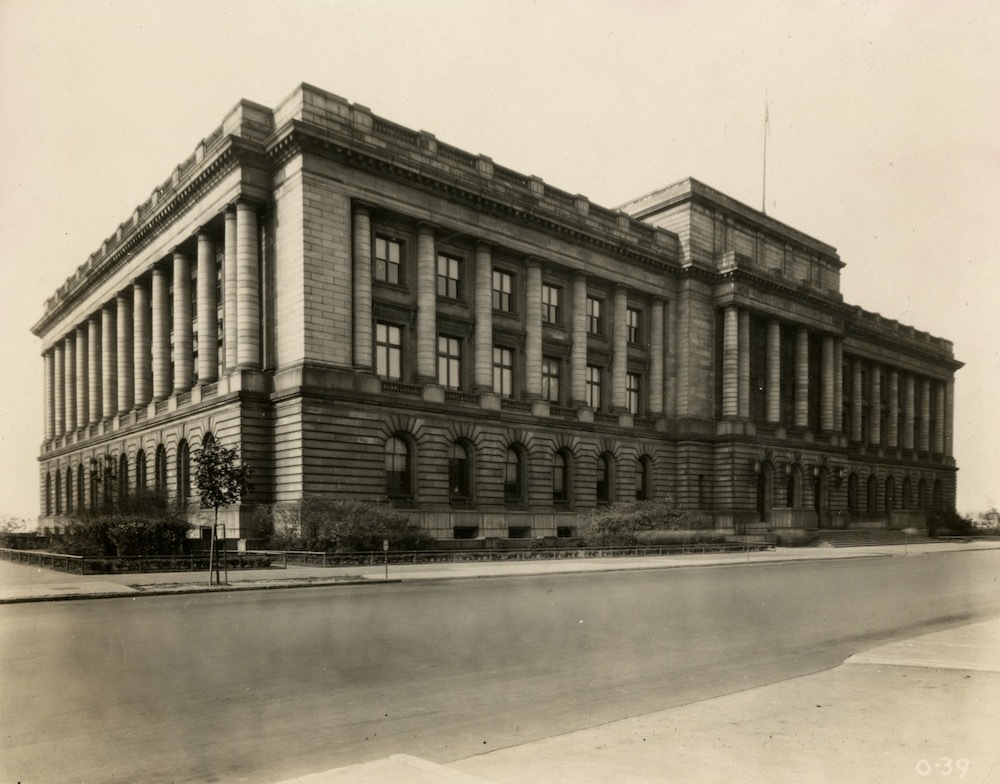Cleveland City Hall

On July 3, 1916, Cleveland city councilmen convened for their weekly meeting. But this was no ordinary get-together. Instead, it was the legislators’ inaugural gathering in Cleveland’s glamorous new city hall at 601 Lakeside Avenue—the very first Cleveland building constructed specifically to function as council chambers. Previously, Cleveland's council chambers had shared roofs with retailers and private and commercial offices. The first place local government business was conducted was in a log cabin.
On April 5, 1802, the first Cleveland Township elections took place at the home of James Kingsbury, one of Cleveland's most important pioneers. After that spring, the Kingsbury home (now the site of the Federal Building at East 9th Street and Lakeside Avenue) became the site of township elections and government meetings, and remained so until 1815. In November, 1836, Cleveland finally had a city council, and the newly elected councilmen chose the two upper floors of the Jones Building, located southwest of Public Square, as their city hall.
In the summer of 1875, Cleveland's city hall headquarters moved to the Case Block: a commercial building on Superior Street where the Cleveland Public Library's main building now stands. For thirty years, Cleveland City Hall shared this building with everything from a ladies clothing store and hotel to artist studios. Not until 1906, when it purchased the Case Block building, was Cleveland able to claim that it had an entire building for its city hall.
Around the time the Case Block building was purchased, plans to build a new city hall were presented to Mayor Tom Johnson. The design was finalized by 1907 and construction began in 1912. Four years later the $3 million building was completed. It was architected by Clevelander J. Milton Dyer, who also designed the Cleveland Athletic Club, the First Methodist Church at 3000 Euclid Avenue, the Coast Guard Station at the mouth of the Cuyahoga River, and myriad residences along Euclid Avenue and in Wade Park (University Circle).
The new City Hall is one of many structures conforming to Daniel Burnham's 1903 Group Plan. Thus its styling is similar to other Group Plan buildings such as the Cuyahoga County Courthouse (1911), Public Auditorium/Music Hall (1922), the Cleveland Board of Education Building (1931, now the Drury Hotel), and the Cleveland Public Library (1925). What may be most striking is the building’s similarity to its neighbor to the west, the Cuyahoga County Courthouse. Both buildings feature bays on each end, balustraded roof lines, and a central pavilion with three entrance bays. City Hall has been designated a historic landmark by the Cleveland Landmarks Commission.
On July 4, 1916, Cleveland welcomed its new government building with a citywide celebration. City Hall's bronze doors were opened at noon and Clevelanders flooded in to see the council chambers and mayor's suite. Concerts of orchestra music and singing filled the building with music. The day ended with the largest fireworks display the city had ever seen.
Since 1916, Cleveland City Hall has undergone several restorations to keep it a functioning location for city affairs. Council Chambers underwent major renovations in 1951 and 1977. However, the façade remains largely unchanged. Today, in addition to the mayor's office, many departments—including City Planning, Finance, Public Health and Public Safety—are housed inside City Hall.
Images



A rendering of the proposed Cleveland City Hall from the Report on the Group Plan, 1907 edition. Source: Cleveland Public Library, Photograph Division







